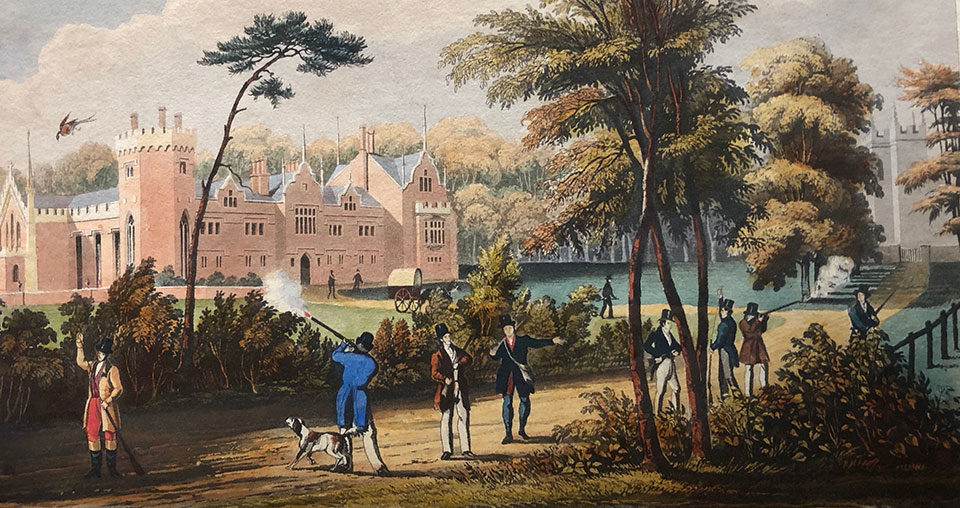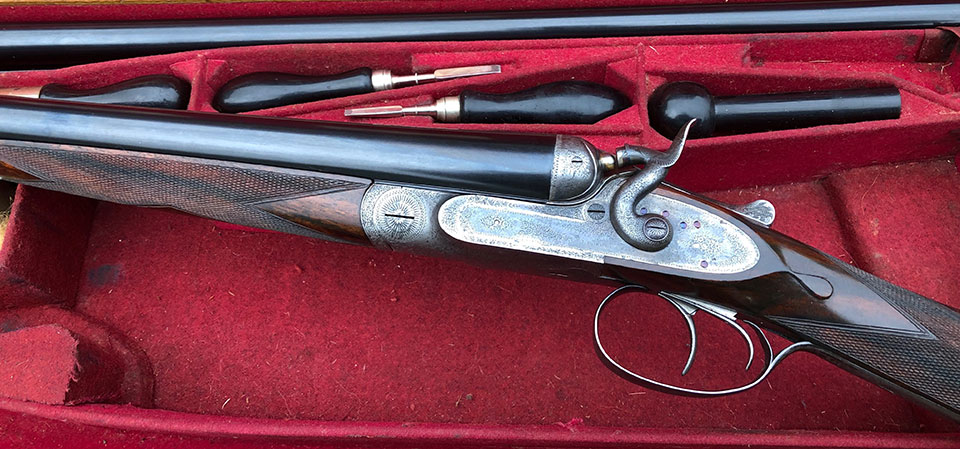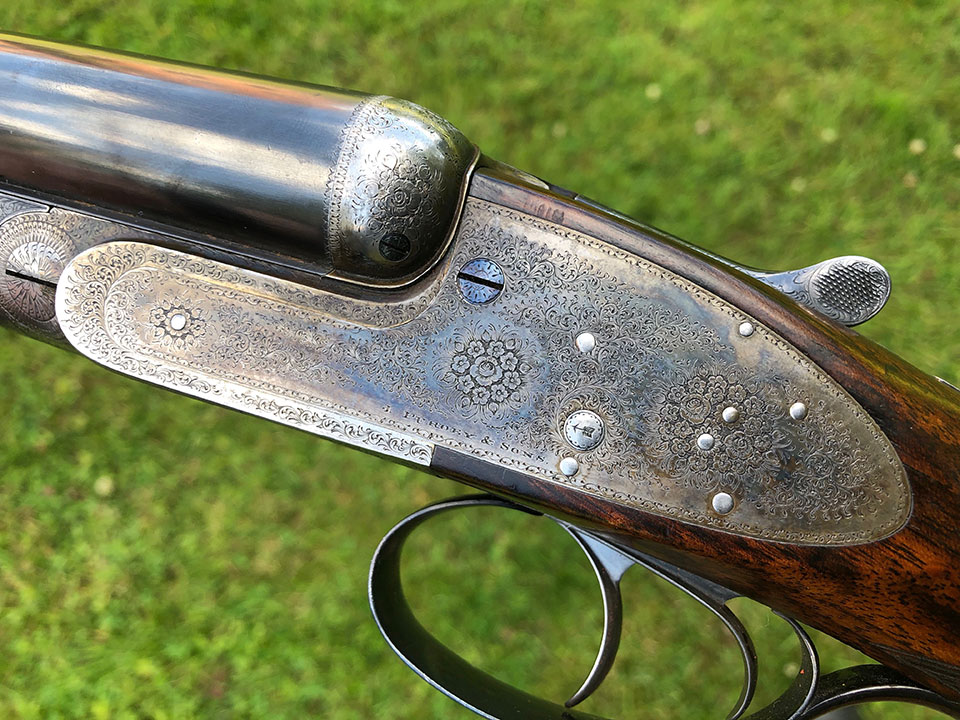Like many old trades, gunmaking has its own peculiar lexicon, which often requires some explanation. Purdey are perhaps unusual, in that its ledgers record the names of the various operations of gun production back as far as 1824. As such, it is possible to trace the evolution of the company’s terminology through the nineteenth century to the terms we use today.
Purdey’s oldest surviving dimension book records the terms for the operations of building a gun as a series of column headers. The initials of the worker who carried out each action were then entered into the relevant column. There were thirteen columns initially, covering:
Barrels
Locks Jointed
Stocked
Screwed together
Making off Check’g + Escuts (Chequering and Escutcheons)
Cocks fitted
Detonating + fin’d (finished)
Polishing work
Engraving
Regulating + finishing
Varnishing + pegs
Browning
Cases
 Cases’ was replaced with ‘Rods’ around 1831, and ‘Cocks fitted’ was dropped entirely in 1835, but otherwise the terms remained relatively consistent until 1850. At some point that year, seven became ‘Detonating Tap’d or Finished’. This is a reference to drilling the holes for the percussion nipples to be fitted, which appears to be described as ‘Pegs’ under number eleven. The list continued to evolve, and had been reduced to ten by 1851:
Cases’ was replaced with ‘Rods’ around 1831, and ‘Cocks fitted’ was dropped entirely in 1835, but otherwise the terms remained relatively consistent until 1850. At some point that year, seven became ‘Detonating Tap’d or Finished’. This is a reference to drilling the holes for the percussion nipples to be fitted, which appears to be described as ‘Pegs’ under number eleven. The list continued to evolve, and had been reduced to ten by 1851:
Locks Jointed
Stocking
Screwed
Made off + finished
Tapped or detonated, finished tapping
Polishing
Engraving
Rods
Pegs
Varnishing
In 1854, several further changes were made. ‘Polishing’ expanded to include ‘Hardening’, and ‘Engraving’ specifically included the naming of barrels. ‘Pegs’ and ‘Varnishing’ were reversed in order, and a column for ‘Cocks’ was added, albeit intermittently.
Although the terminology was evolving, it is clear that the processes behind them had remained relatively stable over those first thirty years, as had the technology. In 1857, one of the biggest advances in gunmaking arrived at Purdey, with the entry for no. 5305: a 13-bore ‘DBL’ gun. In this case, the initials were not for double-barrelled (which was simply recorded as ‘D’ by this time), but ‘Double Breech Loader’.
...many shooters were slow to take up the new technology, and it was only in 1859 that ‘fitting levers’ became a regular entry in the dimension book.
As most of the processes associated with their construction were shared with muzzle-loaders, the only new heading was “Fitting & filing levers to BLoaders”, although this only initially appears on one page in 1857. As perhaps was to be expected, many shooters were slow to take up the new technology, and it was only in 1859 that ‘fitting levers’ became a regular entry in the dimension book. At the same time, as more breech-loaders were produced, so those operations associated with muzzle-loaders were recorded less. Although the columns for ‘Pegs’, ‘Varnishing’ and ‘Rods’ survived, by 1863 they were quite often left blank.
In 1864, the column headers underwent another major change:
Jointing & Stocking
Screwing
Finished & Complete
Percussioning
Cocking
Lever
Engraved
Hardened
Rods
Pegs
Varnish or Buffing
Percussioning’ seems a peculiar choice of terminology, particularly as the trade was moving away from percussion guns. However, it seems to relate to the shaping of the breeches, particularly given where it sits in the order of operations. They have also moved ‘Lever’ to its correct place in the production order. The final column was used only infrequently, at least at first, but quickly became a standard column. Occasionally another column, for ‘Chambering, Rifling & Leading’, was added between nine and ten, or five and six, depending on the layout of the page. However, it was rarely completed, and appears to have been dropped within a year.
 In 1865, Purdey moved another step forward with its first centrefire gun, no. 6992. However, it was not until the following year that two columns were added for features unique to centrefire guns: ‘Strikers’ and ‘Luggers’. These were shoe-horned onto either end of the list, as the columns for ‘Rods’ and ‘Pegs’ were retained for the occasional muzzle-loader. At about the same time, ‘Rifling’ gained a permanent place, although the column was initially headed ‘Rifling & Coning’ for about a year, before settling on ‘Rifling & Chambering’. ‘Strikers’ also disappeared from the list, most likely being combined under ‘Percussioning’. ‘Luggers’ was combined with ‘Varnish & Buffing’, most likely due to their being recorded in adjoining columns, rather than any connection of the two operations.
In 1865, Purdey moved another step forward with its first centrefire gun, no. 6992. However, it was not until the following year that two columns were added for features unique to centrefire guns: ‘Strikers’ and ‘Luggers’. These were shoe-horned onto either end of the list, as the columns for ‘Rods’ and ‘Pegs’ were retained for the occasional muzzle-loader. At about the same time, ‘Rifling’ gained a permanent place, although the column was initially headed ‘Rifling & Coning’ for about a year, before settling on ‘Rifling & Chambering’. ‘Strikers’ also disappeared from the list, most likely being combined under ‘Percussioning’. ‘Luggers’ was combined with ‘Varnish & Buffing’, most likely due to their being recorded in adjoining columns, rather than any connection of the two operations.
By 1870 the headers had been readjusted, with some of the vestigial columns removed, although the order is not entirely in line with the production sequence:
Nipples & Plungers
Jointing & Stocking
Screwing
Finishing
Percussioning
Cocking
Rifling
Levering
Engraving
Hardened
Rods
Luggers
Rubbing off, Buffing up
Nipples and plungers replaced strikers at some point in 1869, although the reason for the change in terminology is unclear. The column for ‘Rods’ was rarely completed, and was eventually reduced to a half column at the end of the list. The term ‘Buffing Up’, together with the loss of the reference to varnish, suggests a change in the stock finish. However, it is not clear whether this indicates a move towards the linseed oil-based finish of today. As with previous changes, it took a couple of pages before entries were made against it, but these remained the nominal stages of making a gun when the first Dimension Book was finished in 1874.
The second ledger overlaps with the first by about a year, starting at 9001. However, the terms had been decided, and so the new book opened with the columns in the correct order of production:
Jointing & Stocking
Screwing
Make off & Finishing
Percussioning
Cocking
Rifling & Chambering
Levering
Nipples & Plungers
Engraving
Hardening
Luggers
Buffing up
Initially, ‘Buffing up’ was rarely completed, although whether this is indicative that it was rarely performed, or simply an oversight in the record-keeping, is impossible to say. Eventually this trend was reversed, and most entries then list an initial in this column. Towards the end of 1874, another heading was added to the end of this list: ‘Snap Forends’. These used the Anson pushrod design, which quickly became the default pattern, even though once again the column was neglected at first.
Towards the end of 1874, another heading was added to the end of this list: ‘Snap Forends’.
More changes appear over the course of 1879. ‘Screwing’ became ‘Screwing & Tip’, and ‘Make off’ became ‘Chequering & finished’. Later the same year, ‘Luggers’ became ‘Luggering’, and ‘Jointing & Stocking’ becomes simply ‘Stocking’. ‘Buffing up’ also seems to be forgotten occasionally, disappearing entirely the following year, although it remains the term used by finishers for polishing the stock to this day.
From no. 10,891, circa 1880 and shortly after the introduction of the Beesley action, the column headings become very similar to those we still use today:
Barrels
Action
Detonating
Stocking
Finishing
Cocking
Nipples & Plungers
Lugger
Lever
Stripping
Engraving
Putting together
Safety
These terms remain unchanged for the remainder of the book, which finished in 1884.
The final ledger of this type only continued to record these details until 1886, when the ledger appears to be a cross-reference between gun numbers and buyers’ accounts. This ledger also has an additional column, as one final action has been incorporated that is specific to the Beesley action:
Barrels
Actions
Detonating
Stocking
Finishing
Cocking
Nipples & Plungers
Rods & Lifters
Lugger
Lever
Stripping
Engraving
Putting together
Safety
Rods & Lifters’ refers to the system which makes a Beesley a true self-opener, transferring the force of the top limb of the mainspring to the barrel flats when the gun is opened.
Published by Vintage Guns Ltd on (modified )



